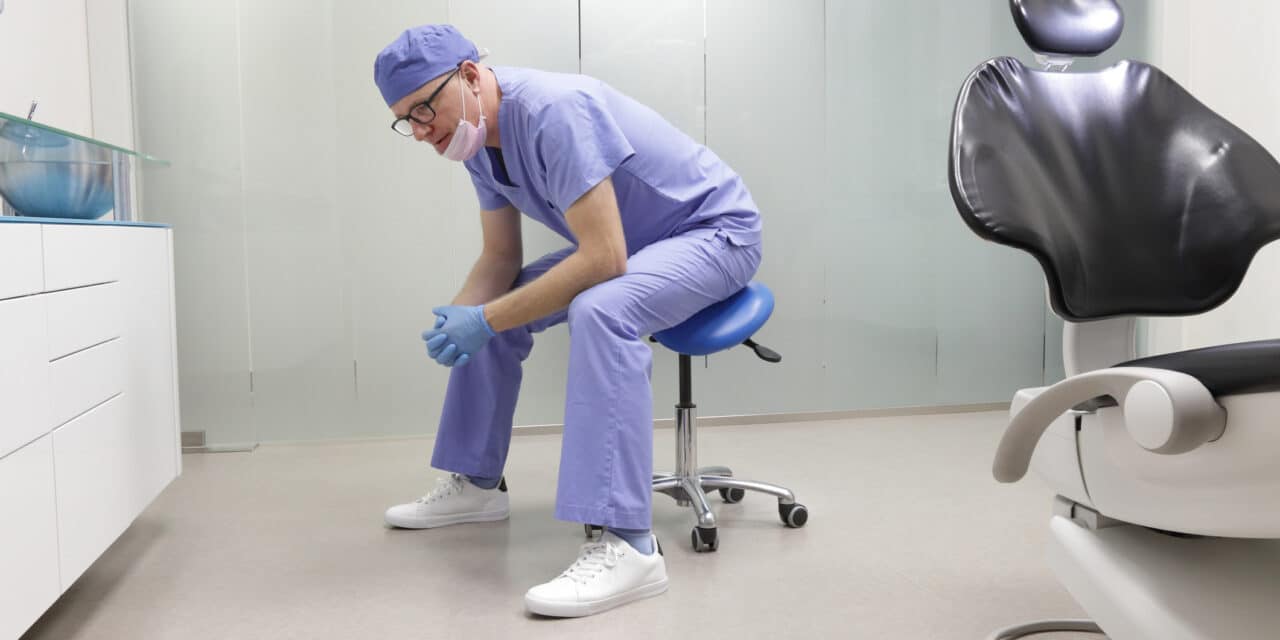Burnout and mental health concerns are emerging as key priorities in orthodontics, prompting new AAO initiatives and conversations about the stressors affecting today’s practitioners.
By Greg Thompson
It’s not hard to find orthodontists who seemingly never want to leave the chairside. They relish the problem-solving challenges of the profession—even the day-to-day admin functions of the office. Did these “lifers” ever feel stress, anxiety, and burnout?
The answer is probably yes, but they rarely talked about it. “Only in the last decade, has mental health really been discussed,” confirms Anil J. Idiculla, DMD, owner of Colorado-based Peak Orthodontics. “I wish previous generations were more open to talk about different hurdles, because it seemed like no one struggled—but we know that’s not the case.”
Michael Sherman, DDS, MBA, a Toronto-based orthodontist and trustee of the Great Lakes Association of Orthodontists, has been in clinical practice for more than three decades. He agrees that the “old days” were often cloaked in silence.
Why Orthodontists Struggle: Stressors Across Career Stages
“Back in the day, mental health certainly was not talked about very much,” confirms Sherman, who is also a trustee liaison on the AAO Mental Wellness Task Force. “People perceived that orthodontists were superstars who would never admit to having any challenges—whether financial, mental, or physical.”
Dentists and orthodontists talked freely about the myriad physical aches and pains of the job, leading to studies and new tech designed to reduce those ailments. “The profession dealt with the ergonomic issues that came with working in a dental chair and leaning over patients all day long,” Sherman remembers, “but not the mental health challenges.”
With many orthodontists still in solo practice, Sherman attributes some of the mental health challenges to loneliness coupled with the inherent stress of managing people. Idiculla agrees, adding that onboarding new staff and cultivating reliable employees is not easy.
Modern Stressors: Staffing, Social Media, and Challenging Patients
“The days of having team members who work with you through retirement are probably gone for many orthodontists, especially in the more urban settings,” Idiculla says. “Hiring and training can be a day-to-day struggle. Social media can add another layer of stress as you see a picturesque world of happiness that may or may not be true. It’s a comparison game that is not particularly healthy for mental wellbeing.”
“Sometimes even patient management is just as challenging, particularly in today’s world where some patients have become more adversarial,” Sherman reports. “They’ve done their research on Google without any real scientific knowledge.”
READ MORE: Reducing Patient Anxiety in Orthodontics with Education Tools
Another stressor, according to Sherman, specific to newer grads is student debt. “Average debt is something like $360,000, so that’s a huge nut to crack,” he says.
AAO’s Mental Wellness Task Force Takes Action
In November 2023, the AAO’s Board of Trustees began to address mental health/burnout concerns in a more systematic way with the creation of an AAO Mental Wellness Task Force. Idiculla and colleagues have used the Task Force to create mental wellness-specific resources and support for members.
The Task Force conducted research among members and learned that mental wellness is indeed an important topic, evidenced by the following survey results:
- 29% of members and 19% of student members are experiencing high stress;
- 70% of members and 92% of student members believe AAO should provide mental wellness resources; and
- 40% of members and 78% of student members would likely use these resources.
Understanding Burnout in Orthodontics
In light of the data, the Mental Wellness Task Force launched a collection of online resources designed to support AAO member mental wellness. Sessions at AAO’s 2024 Annual Conference in New Orleans reflected the new focus with talks such as “Burnout is REAL” by Soumya Padala, BDS, MDS.
“Burnout has become a major concern worldwide, and it is crucial to recognize and prevent it due to the significant impact it can have,” wrote Padala in her intro to the session. “The World Health Organization has acknowledged burnout as an occupational phenomenon.”
In addition to the specific online resources, the AAO has encouraged orthodontists to follow six strategies to improve emotional wellbeing as outlined by the National Institutes of Health. A seventh strategy deals with an orthodontic-specific concern about coping with perfectionism. “Orthodontists are perfectionists by nature,” write AAO officials, “and may be likely to obsess over any imperfection in any aspect of their lives.”
Burnout Can Affect Any Career Stage
With roughly 10% of dental school grads qualifying for orthodontic residency, the stakes are high and the level of dedication is amped up. “We all feel like we’re high performers and invincible,” Sherman agrees. “Even if orthodontists have had a tough time starting the practice, they may feel like they can get through. Maybe they don’t recognize when they’re actually on the edge and may need help.”
When does burnout typically strike? Mid-career? Late career? Idiculla believes the answer is not clear cut. “I think burnout can strike at any time,” he muses. “For new grads, it’s so different than it was 10 to 20 years ago. It seems like it’s more of an uphill battle. It’s harder for new orthodontists than it ever was.”
After years of intense schooling and accumulating debt, the “beginner burnout” can strike sooner than ever. “There are also mid-career orthodontists who had dreamed of a certain way of life, and it’s not turning out that way for different reasons,” adds Idiculla, also a trustee liaison on the AAO Mental Wellness Task Force. “I don’t think any age group is immune to burnout.”
Technology as Both a Stressor and a Solution
Mid- to late-career orthodontists have seen massive changes in technology, even paradigm shifts (eg, aligners in 2000) that have contributed to a feeling of relentless change. Keeping up with new tech is difficult enough, but the internet has only made it tougher with AI overviews contributing to an army of armchair experts.
“Technological advancements have conditioned patients to expect more,” Idiculla agrees. “Trying to live up to these expectations can increase burnout. The best of this technology enables us to practice longer and have it be less taxing day-to-day than it used to be. That may offset some stressors, increase our long-term stamina, and decrease burnout.” Specifically, he sees remote monitoring and AI patient communication tools as technologies that can be of help.
Reconnecting and Resetting: The Role of Community
Meanwhile, the AAO’s Mental Wellness Task Force will continue to address burnout in an effort to discover causes and solutions. The 2026 AAO Annual Session will also tackle the burnout/mental health issue when it convenes May 1-3 in Orlando, Fla. What’s more, the conference is one way to break up the year and re-connect with hundreds of peers who know the pressures (and rewards) of the orthodontic profession.
“In-person meetings go a long way toward decreasing the amount of loneliness we feel, while helping us feel a little more together—both in our struggles and in our victories,” enthuses Idiculla. “There are also some really good online groups—Facebook groups specifically—that offer some virtual camaraderie to really help bring people together.” OP
Greg Thompson is a contributing writer for Orthodontic Products.
Photo: ID 161966030 © Endostock | Dreamstime.com










